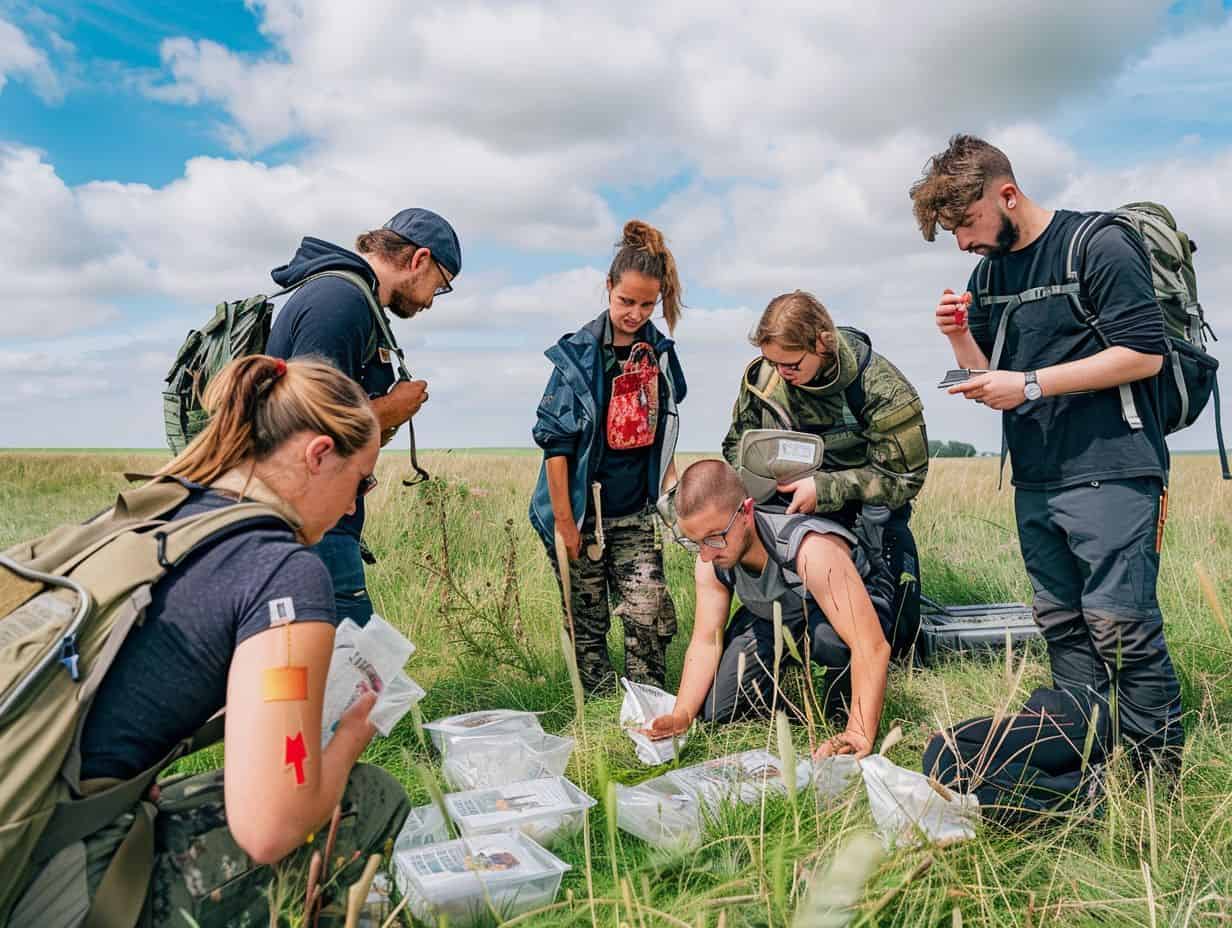In today’s world, sustainability has become a critical aspect of various industries, including the field of MREs. MREs, or Meals Ready-to-Eat, have a significant history of providing sustenance to military personnel and emergency response teams.
The traditional packaging of MREs has sparked concerns about its environmental impact. This article examines the history and types of MREs, investigates the environmental effects of traditional packaging, and explores eco-friendly solutions like biodegradable materials and reusable containers.
Adopting sustainable packaging practices can not only reduce environmental impact but also lead to cost savings and enhanced nutritional value. Despite the advantages, challenges and constraints exist in implementing sustainable MRE packaging.
Looking ahead, innovative packaging designs and collaboration with government and military organizations are crucial for advancing sustainable practices in the field of MREs.
The Importance of Sustainability in the Field
Sustainability in the field is important for minimizing the environmental impact of operations. The use of eco-friendly packaging solutions for MREs can significantly contribute to sustainable practices and conservation efforts in challenging environments.
Not only does eco-friendly packaging for MREs help reduce waste and resource consumption, but it also aligns with broader sustainability goals in field operations. By incorporating innovative approaches like biodegradable materials and recyclable packaging designs, organizations can have a positive impact on the environment while ensuring the efficient delivery of essential supplies.
These sustainability initiatives benefit the ecosystem and also align with the increasing demand for environmentally responsible practices in the supply chain sector.
What are MREs?
MREs, or Meals Ready-to-Eat, are compact and self-contained ration packs designed for quick and easy consumption, making them ideal for field use in various scenarios, including military operations and emergency situations.
These packs are meticulously developed to provide essential nutrients and sustenance to individuals on the go, catering to the demanding requirements of soldiers, first responders, and disaster relief teams.
One significant advantage of MREs lies in their long shelf life and durable packaging, ensuring that they remain viable for extended periods without the need for refrigeration.
The packaging of modern MREs often incorporates sustainable materials, emphasizing eco-friendly solutions to minimize environmental impact while delivering nourishment in challenging conditions.
History of MREs
The history of MREs can be traced back to the mid-20th century when military forces began searching for convenient and nutritionally balanced meal options for field personnel. Over time, MREs have evolved to include sustainability practices and eco-friendly packaging solutions.
One significant innovation in MRE packaging design has been the transition towards using biodegradable materials and recyclable packaging. This shift reflects the broader trend in the food industry to decrease environmental impact. By utilizing materials that decompose easily or can be reused, MREs contribute to a more sustainable approach to providing nourishment in challenging environments. These advancements not only benefit the environment but also support a more efficient and responsible method of delivering essential nutrition to those who depend on MREs.
Types of MREs
There are different types of MREs that are customized for specific purposes such as military operations, outdoor activities, and emergency response. These variations of MREs provide a range of packaging solutions and sustainable practices to meet the requirements of various field scenarios.
For example, military-grade MREs are specifically engineered for compactness and durability to endure harsh conditions in combat areas. They are typically packaged in vacuum-sealed pouches to maintain food freshness and protect against contamination. Conversely, outdoor MREs are designed for hikers and campers, featuring lightweight and portable packaging for easy carrying. Emergency MREs prioritize long shelf life and quick preparation, making them suitable for disaster relief operations.
These different types showcase the versatility and flexibility of MREs in diverse situations, highlighting their importance for various field applications.
The Environmental Impact of Traditional MRE Packaging
The environmental impact of traditional MRE packaging is significant, primarily due to the widespread use of non-biodegradable materials. This results in high levels of waste generation and contributes to environmental degradation in field operations.
The disposal of typical MRE packaging components such as single-use plastic pouches, layered materials, and Styrofoam trays presents a substantial sustainability challenge. These materials decompose very slowly, taking hundreds of years to break down, which leads to landfill congestion and ecological pollution. Additionally, the energy-intensive production processes involved in creating these packaging materials contribute to carbon emissions, further aggravating the issue of climate change.
Given the ongoing expansion of field operations, there is a growing and pressing need for eco-friendly packaging alternatives to address and alleviate the negative environmental consequences.
Non-Biodegradable Materials
The presence of non-biodegradable materials in traditional MRE packaging presents a notable challenge to sustainability efforts in the field, as these materials are responsible for long-term environmental pollution and ecosystem damage.
The longevity and impermeability of non-biodegradable materials in MRE packaging mean they can persist in the environment for extended periods, releasing harmful chemicals and toxins as time passes. This can lead to soil and water source contamination, posing risks to wildlife and disrupting ecosystems.
With increasing awareness of the adverse effects of these materials on the environment, there is a critical need to transition to sustainable packaging alternatives that are biodegradable, compostable, or recyclable. Adopting materials such as plant-based plastics, compostable films, and recycled paper can significantly reduce waste production and lessen environmental impact.
Excessive Waste Production
The excessive waste production linked to traditional MRE packaging contributes to environmental pollution and resource depletion, emphasizing the urgent need for waste reduction strategies and sustainable packaging solutions in field operations.
The accumulation of non-biodegradable packaging materials not only burdens the environment but also presents serious challenges for waste management in field settings. Proper disposal of these MRE packages is often not feasible in remote areas, leading to littering and contamination of natural habitats.
In response to this pressing issue, adopting sustainable practices such as compostable or recyclable packaging options can significantly reduce the ecological footprint of military operations and ensure a more environmentally friendly approach to sustenance in the field.
Exploring Eco-Friendly Packaging Solutions for MREs

Exploring eco-friendly packaging solutions for MREs is important to minimize the environmental impact of field operations. Using biodegradable materials, reusable containers, and compostable packaging can significantly improve sustainability practices in the field.
Biodegradable materials, such as plant-based plastics and natural fibers, provide a sustainable option compared to traditional packaging materials. These materials easily break down in the environment, reducing the strain on landfills and ecosystems.
Reusable containers not only aid in waste reduction but also support a circular economy by prolonging the lifespan of packaging. Compostable packaging, crafted from organic materials like cornstarch or sugarcane, enriches the soil when appropriately disposed of, creating a sustainable end-of-life cycle for MRE packaging.
Biodegradable Materials
Biodegradable materials provide a sustainable alternative for MRE packaging, as they naturally decompose, reducing the environmental impact of waste disposal in field environments.
These materials not only assist in reducing the carbon footprint but also help maintain a healthier ecosystem by preventing the accumulation of non-biodegradable waste. Adopting biodegradable packaging for MREs aligns with the global trend towards sustainable practices, as it aids in preserving natural resources and decreasing pollution. Biodegradable materials require less energy to manufacture compared to traditional packaging materials, further increasing their environmentally friendly attributes. By selecting biodegradable options, military personnel can actively contribute to promoting environmental conservation and alleviating the adverse effects of plastic waste on wildlife and marine ecosystems.
Reusable Containers
Utilizing reusable containers for MRE packaging supports waste reduction and sustainability efforts by reducing single-use packaging waste in field operations. The adoption of reusable containers aids in diminishing the volume of plastic and cardboard waste produced in military field tasks while promoting environmentally friendly packaging practices. By employing sturdy and enduring containers, military personnel can notably decrease the environmental footprint linked to disposable packaging materials.
This transition towards sustainability corresponds with the increasing worldwide focus on eco-conscious behaviors and fosters environmentally friendly practices in a range of operational environments.
Compostable Packaging
Compostable packaging options for MREs facilitate the decomposition of packaging materials into organic matter, providing a sustainable solution for waste reduction and minimizing environmental impact in field settings.
These innovative packaging solutions not only aid in reducing the burden on landfills but also play a vital role in advancing environmental sustainability. By incorporating compostable materials, the overall ecological footprint of MRE packaging sees a significant decrease, supporting a greener and more responsible approach to packaging food.
Compostable packaging presents a more environmentally friendly option compared to traditional plastic packaging, as it naturally breaks down without leaving harmful residues in the environment. Embracing compostable materials in MRE packaging aligns with the global trend towards eco-conscious decisions and emphasizes the significance of sustainable packaging alternatives for ongoing environmental preservation endeavors.
Benefits of Using Eco-Friendly Packaging for MREs
The use of eco-friendly packaging for MREs provides several advantages, such as decreased environmental impact, cost efficiency, and enhanced nutritional quality, establishing it as a sustainable option for field operations.
By giving precedence to sustainable packaging solutions, field personnel can effectively diminish the carbon footprint linked with conventional packaging materials. This transition towards environmentally conscious methods not only supports eco-friendly initiatives but also plays a role in long-term environmental conservation.
The incorporation of biodegradable materials in MRE packaging promotes a more robust ecosystem by reducing plastic waste and harmful chemicals that often seep into the environment. These sustainable approaches not only protect the planet but also improve operational effectiveness, resulting in significant cost savings for military organizations.
Reduced Environmental Impact
Transitioning to eco-friendly packaging leads to a decreased environmental impact by cutting down on waste generation, reducing carbon footprint, and supporting conservation initiatives in field operations.
This move towards eco-friendly packaging for MREs not only has positive impacts on the environment, but also aligns with the increasing focus on sustainability in field operations. By minimizing waste production, these sustainable practices address the issues related to excessive packaging materials that frequently end up in landfills.
The integration of eco-friendly packaging results in a notable reduction in carbon emissions, contributing to broader initiatives aimed at mitigating climate change and advocating for a more sustainable future for future generations.
Cost Savings
Utilizing eco-friendly packaging solutions for MREs has the potential to generate significant cost savings in the long term. Sustainable materials and practices tend to enhance resource utilization efficiency and facilitate waste reduction.
By incorporating renewable and recyclable materials into packaging, companies can reduce production costs and minimize expenses linked to waste management. Adoption of sustainable packaging strategies not only supports environmental objectives but also enhances brand reputation and appeals to environmentally conscious consumers.
With a growing emphasis on sustainable development, investments in innovative packaging solutions can yield lasting economic advantages by cutting overhead expenses and improving operational efficiency. Embracing eco-friendly packaging practices can confer a competitive advantage in the market and contribute to a more sustainable future.
Improved Nutritional Value

Eco-friendly packaging solutions play a significant role in enhancing the nutritional value of MREs by preserving food quality, freshness, and safety. This ensures that field personnel receive high-quality sustenance during operations.
Utilizing sustainable packaging materials and innovative design techniques helps protect the nutrients in the meals ready-to-eat (MREs) from degradation caused by external factors like light, moisture, and oxygen. This preservation is essential for maintaining the vitamins, minerals, and overall nutritional content of the food, ensuring that individuals consuming these rations receive the necessary sustenance for their physical well-being.
Sustainable packaging not only aids in reducing food waste and environmental impact but also contributes to delivering wholesome and nourishing meals to those in need.
Challenges and Limitations of Implementing Sustainable MRE Packaging
The implementation of sustainable MRE packaging is faced with various challenges, including the cost and availability of eco-friendly materials, logistical constraints, and the necessity for innovative solutions to tackle sustainability in field operations.
These challenges highlight the significant barriers that companies face when striving to embrace sustainable packaging practices in military and emergency food supplies. One primary challenge is the higher initial expenses related to eco-friendly packaging materials. Although traditional packaging may be more economical, the enduring advantages of sustainable packaging, like decreased environmental impact, deem it a crucial investment. The restricted availability of sustainable materials can impede widespread adoption. Moreover, logistical intricacies further complicate the transition to sustainable packaging, necessitating a reassessment of supply chains and distribution networks to ensure effectiveness and cost-efficiency.
Cost and Availability of Eco-Friendly Materials
The cost and availability of eco-friendly materials pose significant challenges in the adoption of sustainable MRE packaging, necessitating investment in research, development, and sourcing to address these limitations.
One key strategy to alleviate these constraints is for corporations to engage in collaborations with universities and research institutions to stimulate innovation in sustainable material development. By nurturing these partnerships, companies can access cutting-edge research and leverage a pool of experts, expediting the discovery of cost-effective eco-friendly packaging solutions.
Leveraging economies of scale through bulk purchasing or standardized production processes can assist in cost reduction. Embracing a circular economy approach, where materials are recycled and repurposed, can also improve material availability and affordability for MRE packaging applications.
Logistical Challenges
Issues like storage, transportation, and distribution complexities present challenges to implementing sustainable MRE packaging solutions in field operations, necessitating strategic planning and coordination. The successful use of eco-friendly MRE packaging requires detailed organization and execution to maintain efficient supply chain management in challenging conditions.
Sustainable packaging materials need to be stored properly to preserve their quality during transportation, requiring innovative design strategies that emphasize durability and weight efficiency. Collaborating with different stakeholders to streamline distribution processes is essential for minimizing waste and maximizing resources in field operations, showcasing a strategic approach that addresses environmental considerations alongside operational requirements.
Future Directions for Sustainable MRE Packaging
Future directions for sustainable MRE packaging involve innovative packaging designs, collaboration with government and military organizations, and continuous efforts to enhance sustainability practices in field operations.
Innovative strides are being made in the field of sustainable packaging, with a focus on materials that are eco-friendly and easily recyclable, reducing environmental impact. These advancements also aim to improve logistics efficiency and reduce waste in military operations, aligning with global sustainability goals.
Partnering with government agencies and military entities allows for greater influence and implementation of sustainable practices on a larger scale. As technology progresses, there is an increasing demand for smart packaging solutions that not only protect the contents but also provide valuable data for better tracking and management.
Innovative Packaging Designs
Innovative packaging designs are important for enhancing the sustainability of MRE packaging. They provide creative solutions to reduce environmental impact and improve efficiency in field operations. These designs help preserve food quality and safety during storage and transportation, while also contributing to waste reduction and resource optimization. By incorporating eco-friendly materials, biodegradable options, and efficient design elements, these innovative packaging solutions support sustainability principles and meet the specific requirements of military personnel and emergency responders in the field.
Collaboration with Government and Military Organizations
Working with government and military organizations is crucial for driving sustainable MRE packaging initiatives. This collaboration fosters partnerships that support eco-friendly practices and encourage innovation in field operations.
These partnerships not only improve the efficiency and effectiveness of packaging solutions for military rations but also play a significant role in advancing environmental conservation efforts. By collaborating, both public and private sectors can combine their resources, expertise, and research capabilities to create packaging materials that are biodegradable, recyclable, and reduce waste. Such collaborations allow for the exchange of best practices and technologies, leading to the implementation of cutting-edge sustainable solutions that contribute to a more environmentally friendly future.
Frequently Asked Questions

What is sustainability in the field?
Sustainability in the field refers to the practice of using resources and techniques that minimize negative impact on the environment while promoting long-term conservation and preservation for future generations.
Why is sustainability important when exploring packaging solutions for MREs?
Sustainability is important in packaging solutions for MREs because it ensures that the packaging materials used are not harmful to the environment and can be easily disposed of or reused in a sustainable manner.
What are some examples of eco-friendly packaging solutions for MREs?
Some examples of eco-friendly packaging solutions for MREs include biodegradable materials, reusable containers, and compostable packaging.
How do eco-friendly packaging solutions impact the overall sustainability of MREs?
Eco-friendly packaging solutions can greatly impact the overall sustainability of MREs by reducing the amount of waste generated and promoting more sustainable practices in the field.
What challenges may arise when implementing sustainable packaging solutions for MREs in the field?
Challenges that may arise include the availability and accessibility of sustainable packaging materials, durability and effectiveness in harsh environments, and cost-effectiveness compared to traditional packaging materials.
What steps can be taken to promote sustainability in the field when using MREs?
Steps that can be taken include educating and training personnel on proper disposal and recycling of packaging materials, implementing waste reduction strategies, and continuously seeking out and implementing more eco-friendly packaging solutions.


